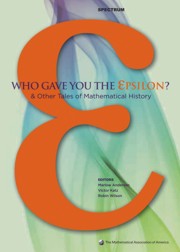Book contents
- Frontmatter
- Introduction
- Contents
- Analysis
- Geometry, Topology and Foundations
- Foreword
- Gauss and the Non-Euclidean Geometry
- History of the Parallel Postulate
- The Rise and Fall of Projective Geometry
- Notes on the History of Geometrical Ideas
- A note on the history of the Cantor set and Cantor function
- Evolution of the Topological Concept of “Connected”
- A Brief, Subjective History of Homology and Homotopy Theory in this Century
- The Origins of Modern Axiomatics: Pasch to Peano
- C. S. Peirce's Philosophy of Infinite Sets
- On the Development of Logics between the two World Wars
- Dedekind's Theorem:√2 × √3 = √6
- Afterword
- Algebra and Number Theory
- Surveys
- Index
- About the Editors
Foreword
from Geometry, Topology and Foundations
- Frontmatter
- Introduction
- Contents
- Analysis
- Geometry, Topology and Foundations
- Foreword
- Gauss and the Non-Euclidean Geometry
- History of the Parallel Postulate
- The Rise and Fall of Projective Geometry
- Notes on the History of Geometrical Ideas
- A note on the history of the Cantor set and Cantor function
- Evolution of the Topological Concept of “Connected”
- A Brief, Subjective History of Homology and Homotopy Theory in this Century
- The Origins of Modern Axiomatics: Pasch to Peano
- C. S. Peirce's Philosophy of Infinite Sets
- On the Development of Logics between the two World Wars
- Dedekind's Theorem:√2 × √3 = √6
- Afterword
- Algebra and Number Theory
- Surveys
- Index
- About the Editors
Summary
One of the most important aspects of geometry in the nineteenth century was the development of non-Euclidean geometry, and this chapter begins with two brief studies of aspects of its development. In the first, George Bruce Halsted reviews volume VII of Gauss's Werke and concludes from a study of many of Gauss's letters first published in that volume that Gauss's ideas on the subject had no influence on the independent discoveries of János Bolyai and Nikolai Lobachevsky, or on the earlier publication by Ferdinand Karl Schweikart (1780–1859). In the second article, Florence P. Lewis gives us a whirlwind tour through the history of the parallel postulate, from Proclus to Bolyai and Lobachevsky. She then proposes how this history, and its effect in how mathematicians understood the nature of a postulate, could affect the teaching of geometry in schools. In particular, she emphasizes that one reason for the study of geometry is its role in “training the mind.”
Another major aspect of nineteenth-century geometry was the development of projective geometry. That development began in the seventeenth-century work of Girard Desargues and Blaise Pascal, but, as Julian Lowell Coolidge notes, it then “dragged along” for about a century. In his article, Coolidge takes up the story in the nineteenth century, summarizing the work of such mathematicians as Jean-Victor Poncelet, Michal Chasles, Jacob Steiner, and Johann Karl Christian von Staudt. But then Coolidge remarks that by the end of the nineteenth century, the field of synthetic projective geometry was “pretty much worked out.”
- Type
- Chapter
- Information
- Who Gave You the Epsilon?And Other Tales of Mathematical History, pp. 113 - 114Publisher: Mathematical Association of AmericaPrint publication year: 2009

